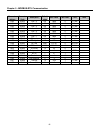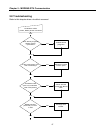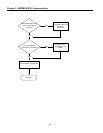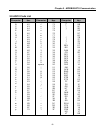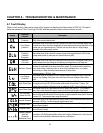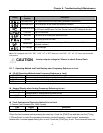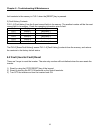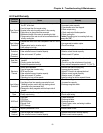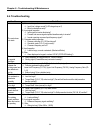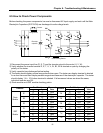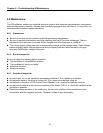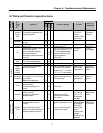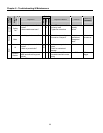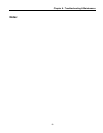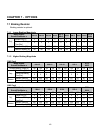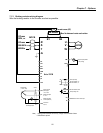
Chapter 6 - Troubleshooting & Maintenance
94
6.4 Troubleshooting
Condition Check Point
The motor does
not rotate
1) Main circuit inspection
☞ Input (line) voltage normal? (LED charge lamp on?)
☞ Motor connected correctly?
2) Input signal inspection
☞ Input signal to inverter functioning?
☞ Forward and reverse signals inputted simultaneously to inverter?
☞ Inverter receiving command input frequency signal?
3) Parameter setting inspection
☞ Reverse prevention (FU1-03) function set?
☞ Operation mode (FU1-01) set correctly?
☞ Command frequency set to 0?
4) Load inspection
☞ Load too large, or motor restrained. (Mechanical Brake)
5) Other
☞ Alarm displayed on keypad, or alarm LED lit? (STOP LED blinking?)
The motor rotates
in opposite
directions
☞ Phase sequence of output terminal U, V and W correct?
☞ Starting signal (Forward/Reverse) connected correctly?
The difference
between the
rotating speed and
the reference is
too big
☞ Reference frequency verified? (Check the level of input signal)
☞ Following parameter setting verified?
Lower Limit Frequency (FU1-24), Upper Limit Frequency (FU1-25), Analog Frequency Gain (I/O-
1~10)
☞ External noise? (Use a shielded wire)
The inverter does
not accelerate or
decelerate
smoothly
☞ Acceleration/Deceleration time too short.
☞ Load too large?
☞ Torque Boost (FU1-27, 28) value too high? (Current limit function and the stall prevention
function verified?)
The motor current
is too high
☞ Load too large?
☞ Torque Boost Value (manual) too high?
The rotating
speed does not
increase
☞ Upper Limit Frequency (FU1-25) value correct?
☞ Load too large?
☞ Torque Boost (FU1-27, 28) value too high? Is Stall prevention function (FU1-59, 60) verified?
The rotating
speed oscillates
when the inverter
is operating.
1) Load inspection
☞ Load oscillating?
2) Input signal inspection
☞ Reference frequency signal oscillating?
3) Other
☞ Wiring too long? (Over 500m, 1,500ft)



